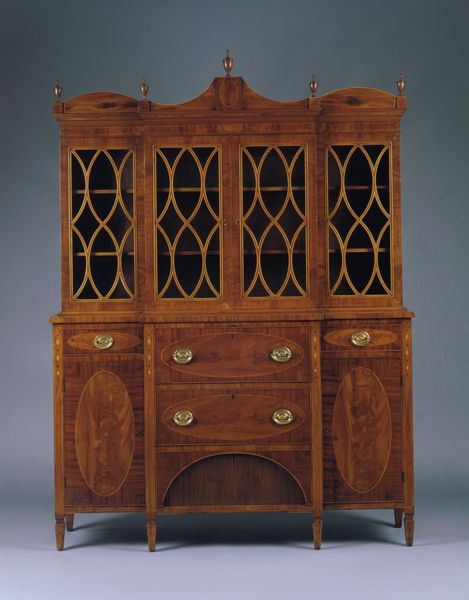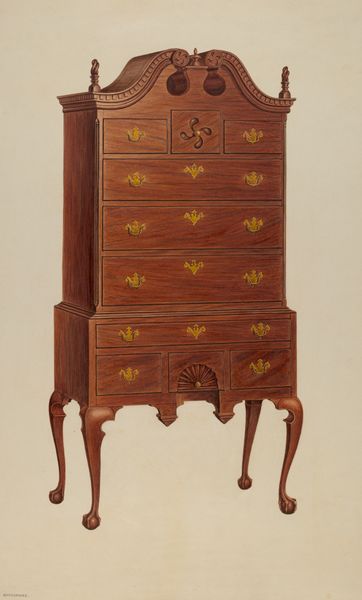
wood
#
neoclacissism
#
wood texture
#
furniture
#
traditional architecture
#
wooden texture
#
wood
#
decorative-art
Dimensions: 220.4 × 105.4 × 53.3 cm (86 3/4 × 41 1/2 × 21 in.)
Copyright: Public Domain
Curator: Standing before us is an intriguing piece entitled "Desk and Bookcase," dating back to the early 19th century, sometime between 1800 and 1815. It now resides here at the Art Institute of Chicago. Editor: The initial impression is of a self-contained world—so neat, so orderly. Almost intimidatingly composed. It gives a distinct air of restrained ambition. Curator: That resonates with the period's Neoclassical influences. Furniture like this became a stage for displaying one’s aspirations toward the ideals of reason, order, and civic virtue. The object being crafted of wood imbues it with an organic naturalism in stark juxtaposition to the themes it carries. Editor: Do you see how the wood grain mimics flames, creating a sense of tension? But the perfectly spaced brass knobs and symmetrical inlay, like formalized solar motifs, pull against it. Are we seeing a material dialogue here about self-control and natural passion? Curator: It's also about projecting a specific kind of power, the power of literacy and knowledge. Owning a desk and bookcase signaled intellectual and social status within a rapidly changing world. Displaying that knowledge via green curtains no less! The desk quite literally obscures the means and foundations upon which that intellectual process takes place. Editor: It is all so rigidly compartmentalized though. Even the colour scheme is restricted to wooden brown and brass with the ever so striking and alluring, lush emerald fabric that so prominently lies beneath. Is there any room for something to grow or some deviation in such a tightly curated space? Or are we just projecting our modern sensibilities here? Curator: Projecting and remembering. Decorative objects like this held significant weight in constructing social memory, reminding viewers of cultural ideals and perhaps prompting aspirations of their own. What narratives and counter-narratives were built in such confined conditions of domestic aspiration and memory? Editor: Absolutely. It makes you consider how carefully people cultivated their image. Each book placed deliberately. Each letter meticulously composed. A curated theatre of self and status. Curator: Indeed. This piece acts as a microcosm, reflecting larger social structures and values, rendered materially manifest through artistry and design. It acts as a looking glass onto both personal and political life of early 19th century. Editor: Thanks to works such as this one we can revisit a moment in our global history when the burgeoning power of books first presented itself in full maturity. An artifact like this gives a deeper context from which to look into and comprehend ourselves today.
Comments
No comments
Be the first to comment and join the conversation on the ultimate creative platform.













